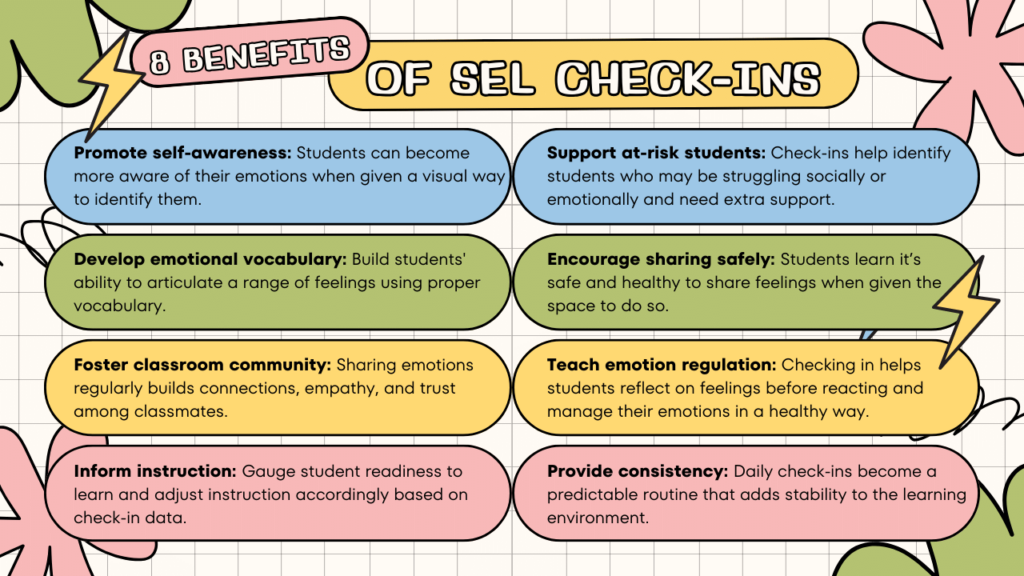Student Check-Ins

All students need this every day, but some students need more. Equity means matching your use with students’ needs.
Definition: A brief (~1 minute) interaction, often initiated by asking a question, in which the teacher tries to connect with the student personally to increase trust and positivity within the student-teacher relationship.
Purpose: Check-ins are an important tool for educators to explore identity within themselves and their students.
Ask families and students about student interests.

Resources for K-2 Educators
Documents
Click here (Word) for a downloadable and editable email to send to families.
Videos
This 4-min video demonstrates how supporting families can help facilitate student success.
Resources for 3-5 Educators
Documents
Click here (Word) for a downloadable and editable email to send to families.
Videos
This 4-min video demonstrates how supporting families can help facilitate student success.
Enhance depth and quality by showing curiosity and authenticity during check-ins.

Resources for K-2 Educators
Documents
Click here (Word) for an interest survey you can give to your students.
Click on this link: Classroom Life Measure (Word) for a survey you can download and give to your students to assess how students feel about you, as their teacher. This can be used to get an idea of your relationships with students.
Handouts
This handout (pdf), from the Center for Intervention Research in Schools, provides useful tips, action steps, and resources for student check-ins.
Websites
This website lists 21 questions you can ask students for check-ins.
Videos
This 3-minute video, above, involves a discussion among three educators about individual student check-ins and how it can promote student engagement.
This 1-minute video, above, is an example of a quick check-in by asking students to rate their day.
Resources for 3-5 Educators
Documents
Click here (Word) for an interest survey you can give to your students.
Click on this link: Classroom Life Measure (Word) for a survey you can download and give to your students to assess how students feel about you, as their teacher. This can be used to get an idea of your relationships with students.
Handouts
This handout (pdf), from the Center for Intervention Research in Schools, provides useful tips, action steps, and resources for student check-ins.
Websites
This website lists 21 questions you can ask students for check-ins.
Videos
This 3-minute video, above, involves a discussion among three educators about individual student check-ins and how it can promote student engagement.
Check-in at least once or twice each week with all students in the class.

Resources for K-2 Educators
Documents
Click here for student tracking sheet for check-ins (Word).
Click here for student tracking sheet for check-ins (Excel).
Handouts
This handout (pdf) is a useful and informative break-down of a check-in board you can use to assess student mood.
Websites
This website defines and explains how you can create student engagement by tapping into student interests, making material current, and using roles within the classroom.
Videos
This 4-minute video, above, demonstrates how Check-In / Check-Out can be used as an effective daily support system for students.
This 3-minute video, above, shows how educators can reflect and develop strategies to get to know and build connections with students.
Resources for 3-5 Educators
Documents
Click here for student tracking sheet for check-ins (Word).
Click here for student tracking sheet for check-ins (Excel).
Handouts
This handout (pdf) is a useful and informative break-down of a check-in board you can use to assess student mood.
Websites
This website defines and explains how you can create student engagement by tapping into student interests, making material current, and using roles within the classroom.
Videos
This 4-minute video, above, demonstrates how Check-In / Check-Out can be used as an effective daily support system for students.
This 3-minute video, above, shows how educators can reflect and develop strategies to get to know and build connections with students.
Examples:
- To help you understand the student’s emotional state or mood: Welcome, Kayla! What emotion zone are you in today?
- In the context of learning: Shiloh, which character do you think you are most like?
- During transitions: Chantelle, I noticed you talking about Pokemon cards. Who is your favorite Pokemon?
- Events that are meaningful to the individual student: It is exciting that tomorrow is the beginning of Diwali! Do you have any plans for this time Aditi?
- Paired with a greeting: Good morning, Hakim. It’s great to see you! What did you do after school yesterday?
Tips:
- Consider bending or squatting to be at the student’s eye level during a check-in.
- Use information learned during a check-in to help differentiate instruction and facilitate student engagement in learning (e.g., highlighting what the student enjoys reading, writing, talking, or drawing about).
- Consider using check-ins as an opportunity to review and practice prosocial skills (e.g., emotion regulation, deep breathing, perspective taking, problem solving, and communication skills).
- Be aware that some students cope best by having space (and not talking) and/or by simply knowing/hearing that the teacher cares. In this case, simply reflect the students’ feelings and let them know you are there.
- Remember, you do not have to find a solution in the moment. Some students appreciate just being heard and supported (e.g., I understand that is a difficult situation. I care about you)
- Designate a physical space to give students the opportunity to self-regulate, if needed (e.g., Take-A-Break, Check-In and/or Peace Table space)
- Remember that emotions may be expressed differently by students with different cultural backgrounds or lived experiences, so it can be helpful to ask the student what emotion they are feeling rather than making an assumption.
- Use check-ins with students who have had an argument. Give both students a voice describing the situation, and in considering solutions or reparations. This acknowledges the harm(s) experienced during the interaction.
